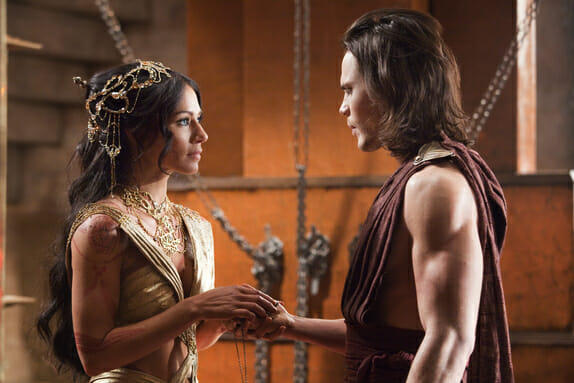John Carter

Based on the series of not-Tarzan novels first written by Edgar Rice Burroughs in 1911, Andrew Stanton’s John Carter is a disappointment over 100 years in the making. And considering how many established sci-fi/fantasy cinematic classics owe their very existence to Burroughs’ original stories, that’s really too bad. Many directors have attempted to get a John Carter film off the ground—most recently, Iron Man’s Jon Favreau—but only Finding Nemo and Wall-E helmer Stanton had been able to successfully convince the suits at Disney to back his vision to the tune of a reported $250 million. The money’s certainly accounted for in terms of grand visual punch, but where’s the rest of it?
John Carter tells the story of a scrappy ex-confederate soldier looking for his fortune while evading Union forces attempting to conscript him back into service. After a standoff between soldiers and Apache goes badly, Carter escapes to a cave containing not only his fortune in gold, but a MacGuffin capable of projecting him instantly to Barsoom (Mars). There, he’s a man with super powers thanks to the planet’s lighter gravity and quickly becomes embroiled in a planetary war. Soon enough, he’s leading giant multi-limbed warrior Tharks along with a (scene-stealing) 10-legged, reptilian dog-like Woola, and defending a beautiful rust-hued princess from the perils of forced marriage.
Sadly, the rollicking adventure described above is delivered only fitfully. The production design by frequent-Christopher Nolan collaborator, Nathan Crowley, is top-notch, smartly incorporating a wonderful retro-future motif to sets, vehicles and various apparatus. But somehow the script, co-written by Michael Chabon (The Amazing Adventures of Cavalier and Clay, as well as the screenplay of the outstanding Spider-Man 2), proves a convoluted mishmash of disparate elements from multiple John Carter books, creating a muddle of what could have been sprightly paced, pulpy fun. The studio’s ambition to turn John Carter into a franchise is obvious—and expected—so why did the filmmakers overburden this first entry with so much momentum-grinding, extraneous exposition every 15 minutes or so?
-

-

-

-

-

-

-

-

-

-

-

-

-

-

-

-

-

-

-

-

-

-

-

-

-

-

-

-

-

-

-

-

-

-

-

-

-

-

-

-








































